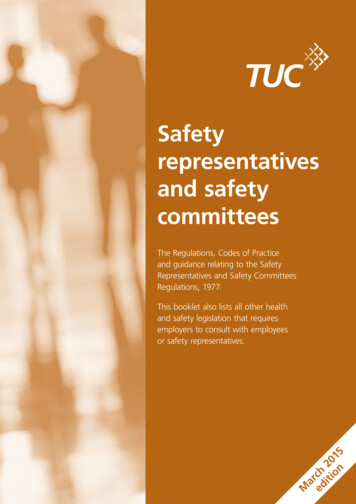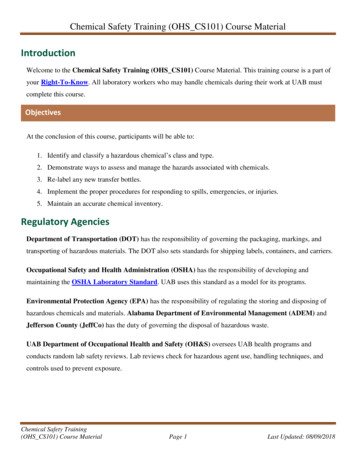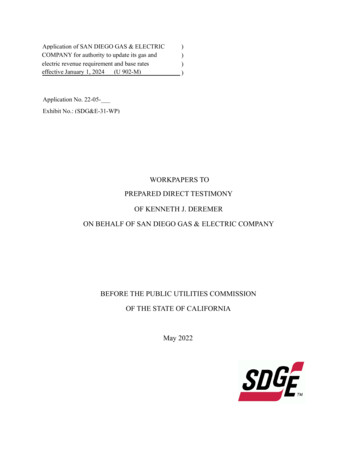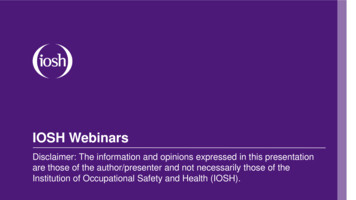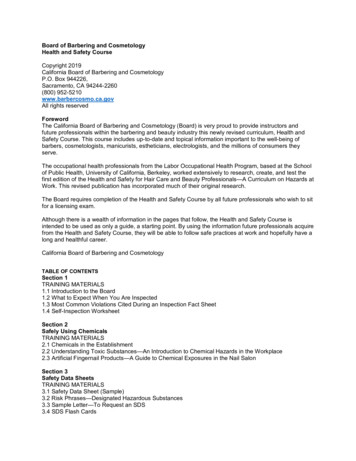
Transcription
Board of Barbering and CosmetologyHealth and Safety CourseCopyright 2019California Board of Barbering and CosmetologyP.O. Box 944226,Sacramento, CA 94244-2260(800) 952-5210www.barbercosmo.ca.govAll rights reservedForewordThe California Board of Barbering and Cosmetology (Board) is very proud to provide instructors andfuture professionals within the barbering and beauty industry this newly revised curriculum, Health andSafety Course. This course includes up-to-date and topical information important to the well-being ofbarbers, cosmetologists, manicurists, estheticians, electrologists, and the millions of consumers theyserve.The occupational health professionals from the Labor Occupational Health Program, based at the Schoolof Public Health, University of California, Berkeley, worked extensively to research, create, and test thefirst edition of the Health and Safety for Hair Care and Beauty Professionals—A Curriculum on Hazards atWork. This revised publication has incorporated much of their original research.The Board requires completion of the Health and Safety Course by all future professionals who wish to sitfor a licensing exam.Although there is a wealth of information in the pages that follow, the Health and Safety Course isintended to be used as only a guide, a starting point. By using the information future professionals acquirefrom the Health and Safety Course, they will be able to follow safe practices at work and hopefully have along and healthful career.California Board of Barbering and CosmetologyTABLE OF CONTENTSSection 1TRAINING MATERIALS1.1 Introduction to the Board1.2 What to Expect When You Are Inspected1.3 Most Common Violations Cited During an Inspection Fact Sheet1.4 Self-Inspection WorksheetSection 2Safely Using ChemicalsTRAINING MATERIALS2.1 Chemicals in the Establishment2.2 Understanding Toxic Substances—An Introduction to Chemical Hazards in the Workplace2.3 Artificial Fingernail Products—A Guide to Chemical Exposures in the Nail SalonSection 3Safety Data SheetsTRAINING MATERIALS3.1 Safety Data Sheet (Sample)3.2 Risk Phrases—Designated Hazardous Substances3.3 Sample Letter—To Request an SDS3.4 SDS Flash Cards
3.5 Resource Groups, Agencies, Databases, Trifold and Publications Informational Sheet3.6 Working Safely in Nail Salons Fact Sheet3.7 Independent Contractor or Employee TrifoldSection 4Protection from Hazardous ChemicalsTRAINING MATERIALS4.1 Artificial Nails Fact Sheet4.2 Chemical Hair Relaxers/Straighteners/Blowouts Fact Sheet4.3 Disinfectants Fact Sheet4.4 Hair Bleaches Fact Sheet4.5 Hair Color Fact Sheet4.6 Manicuring Fact Sheet4.7 Permanent Waving Fact Sheet4.8 Shampoos and Conditioners Fact Sheet4.9 Thermal Hairstyling Fact SheetSection 5ErgonomicsTRAINING MATERIALS5.1 Work Smarter, Not Just Harder Poster5.2 Stay Healthy and Safe While Giving Manicures and PedicuresSection 6Communicable DiseasesTRAINING MATERIALS6.1 Diseases in the Workplace ChartSection 7Health and Safety Laws and AgenciesTRAINING MATERIALS7.1 Health and Safety Rights: Facts for California Workers7.2 Health and Safety Agency Acronyms Word SearchSection 8Solving Health and Safety ProblemsTRAINING MATERIALS8.1 Health Survey8.2 Workplace Inspection Checklist8.3 Resource Agencies and Materials Informational SheetSection 9UNDERSTANDING Workers’ Rights and ResponsibilitiesTRAINING MATERIALS9.1 Independent Contractor or Employee9.2 Tax Tips for the Cosmetology and Barber Industry9.3 Tips on Tips9.4 OSHA’s Workers’ Rights9.5 Nail Salon Workers Wage and Hour Rights9.6 Recover Your Unpaid Wages with the California Labor Commissioner’s Office9.7 All Workers Have Rights in California9.8 DIR Required Workplace Posting for All California Barbering and Cosmetology LicenseesSection 10Physical and Sexual Abuse AwarenessTRAINING MATERIALS
10.1 Facts About Elder Abuse10.2 The National Domestic Violence Hotline – Safety Planning10.3 #NoViolenceInBeauty Tool Kit Fact Sheet Building Respect Activity Sheet Contact SheetSection 1The California Board of Barbering and CosmetologyLearning ObjectivesSection 1Welcome to the Board of Barbering and CosmetologyAfter completing this section, the future professional will be able to: Identify the Board’s mission.Access the Board’s website and have a general understanding of what is available on thewebsite.Understand the purpose of the Health and Safety Course.Congratulations on your decision to enter the barbering and beauty industry. You will no doubtfind it both rewarding and fulfilling. So, welcome!The California Board of Barbering and Cosmetology (Board) is very proud to provide future professionalswith a Health and Safety Course. This course includes up-to-date and topical information important to thewell-being of barbers, cosmetologists, estheticians, manicurists, electrologists, and the millions ofconsumers they serve. Occupational health professionals from the Labor Occupational Health Program,University of California, Berkeley, representatives from the California Department of Public Health and theDepartment of Consumer Affairs, in conjunction with the Board, have worked to research, create, test,and revise text material for this course.What Does the Board Do?The Board regulates barbering, cosmetology, skin care, nail care, and electrology services in Californiaas well as the establishments where these services are performed. The Board’s highest priority isprotecting and educating consumers who use barbering, cosmetology, manicuring, esthetic, andelectrology services. Anyone who provides the following services to a consumer for a fee must belicensed by the Board and work in state-licensed establishments or be in possession of a PersonalService Permit, if providing services outside of a state-licensed establishment: Hairdressing and stylingHaircuttingShavingManicuring and pedicuringSkin care (including makeup application and lash extensions)ElectrologyThe Board also regulates health and safety and coursework in barbering, cosmetology, and electrologyschools. The Board shares dual oversight of approved schools with the Bureau of Private PostsecondaryEducation (BPPE). BPPE administers student services and the Student Tuition Recovery Fund, andconducts outreach and educational activities for private postsecondary educational institutions andstudents within the state. The Board regulates the school curriculum and the minimum standards forschool equipment, administers the licensing examination, and enforces health and safety regulations.
These two regulatory entities work closely together to make sure that future professionals and consumersalike are safe in the school environment. Understanding what each entity does can save futureprofessionals frustration as questions arise during schooling. For instance, if there are questionsregarding grants or the student tuition recovery program, or problems with the repayment of a loan occur,contact the Bureau of Private Postsecondary Education. They can be reached at www.bppe.ca.gov or bycalling (888) 370-7589. However, if there are concerns that a school is not providing the properequipment for training, there is a health and safety concern on the campus, or the school is not teachingBoard-required curriculum, contact the Board. The Board wants to make sure future professionals starttheir careers off right by learning good, sound health and safety practices. To help reinforce thatobjective, the Board makes it a practice to regularly inspect schools for health and safety violations.Schools with repeated health and safety violations can have their school codes revoked, which means theBoard will not accept training hours from these schools. To see if a school is Board-approved, go tohttps://www.barbercosmo.ca.gov/schools/approved schools.pdf. In order to sit for a Board licensingexamination, a future professional must receive training from a school with a valid school code issuedfrom the Board.Sidebar: The Board of Barbering and Cosmetology regulates the school curriculum, minimum equipmentheld in the school, and health and safety violations.Sidebar: The Bureau of Private Postsecondary Education administers student services and theStudent Tuition Recovery Fund, and conducts outreach and educational activities for privatepostsecondary educational institutions and students within the state.Image: Screen print of the homepage of the Board’s website www.barbercosmo.ca.govImage: Screen print of the “What’s New” box on the Board’s homepageHow Can I Stay Current With What the Board Requires?Staying current and up-to-date is essential for success in the barbering and beauty industry. In recentyears, the Board has made several changes to its official website www.barbercosmo.ca.gov. Futureprofessionals will want to visit this site frequently and take advantage of the many tools provided.I Don’t Speak or Read English. Now What?Earnest effort has been made to make the material presented on the Board’s website understandable andeasy-to-read. Most publications are translated into English, Spanish, Vietnamese, and Korean. Inaddition, the Google translator button can be found at the bottom of the Board’s website homepage.What is Available on the Board’s Website?The Board’s Mission is proudly displayed on the website’s opening banner: “To ensure the health andsafety of California consumers by promoting ethical standards and by enforcing the laws of the barberingand beauty industry.” This mission reflects the dedication of every Board employee.Notice the different sections on the home page. Pay close attention to the “What’s New” box. Informationappearing in this box will keep future professionals current on Board campaigns, changes in regulations,changes to the licensing exam, or other pertinent information.The “Upcoming Events” section provides information on where the Board will be at any given time,whether it is a trade show, a Board meeting, a disciplinary review hearing, or an invitation to the public toexpress their opinions on any proposed regulatory changes. It is very important to this Board that futureprofessionals stay involved in the industry as they progress through their careers. Most of the changesthat happen with regulation starts with individuals coming to a Board meeting and expressing theirviewpoint. A future professional should make it a goal to come to at least one Board meeting and oneDisciplinary Review Committee hearing before graduating from school.Image: BreEZe Button on the Board's website.Image: Screen print of the Board’s Facebook page
BreEZe and How to Use ItOn the home page, take special note of the BreEZe icon. After clicking on the icon, register so that a userID and password can be created with BreEZe. Registering will allow an individual, when ready, to renewlicenses online without hassle or worry. Fines can also be paid online using the BreEZe system.Consumers can use the “License Search” button to view a license status and disciplinary actions, or to filea complaint.Stay Current With the IndustryOn the home page, notice the “Industry News” section. Future professionals will find it advantageous topay close attention to this section. Periodically, the Board will post “Industry Bulletins.” These bulletinsaddress common trends or services that may be within the scope of practice for licensees. For instance,the esthetic field is bursting with cutting-edge machinery designed for everything from treating scars andlesions to improving product penetration. Check out the Industry Bulletin on machine use and find outwhat should be considered before purchasing an expensive piece of equipment.Rules and RegulationsAt the top of the home page, future professionals will notice the “Laws & Regs” tab. Future professionalsshould make sure to always have a copy of the current laws and regulations. Periodic review of the lawsand regulations is encouraged to avoid compliance difficulties.Stay in Touch!The Board would like to stay connected with all future professionals and licensees as they journeythrough this fabulous career. To receive an email message or notification when the Board is holding ameeting, sign up on the Board’s interested party list. See the Board’s home page under “Quick Hits.” Inaddition, take a moment to “like” the Board on Facebook or follow the Board on Twitter to keep in touchwith what is going on with the Board and the laws that affect the Barbering and Beauty industry.Thinking of a Career Change but Want to Stay in the Industry?Check out the “Job Opportunities” available at the Board. See “Quick Hits” for “Job Opportunities” on theBoard’s website, www.barbercosmo.ca.gov.Questions? We Have Answers!There is a wealth of information at a future professional’s disposal. Take time and view all that the Boardhas made available to future professionals, licensees and consumers. Questions? Email the Board atBarbercosmo@dca.ca.gov.Now Let’s Talk Health and Safety!Each member who served on the revision of the Health and Safety Course is passionate about thebarbering and beauty industry and wants to make sure that all future professionals have the tools neededto be able to have a long and healthy career. The training can either be viewed in a written format or ifavailable, online. The Health and Safety Course is divided into 10 sections. The sections are:Section 1 – The California Board of Barbering and CosmetologyThis section provides an overview of the Board, its mission, and available resources.Section 2 – Safely Using ChemicalsFuture professionals will learn about chemicals that may be found in an establishment that have thepotential to harm an individual’s health. This section discusses why chemicals may be harmful, how theymay get into the human body, and how much exposure is just too much.Section 3 – Safety Data SheetsThis section discusses one of the very best ways to get information on chemicals used in anestablishment: The Safety Data Sheet (SDS). Each section of the SDS will be reviewed and explained indetail.
Section 4 – Protection from Hazardous ChemicalsIn this section future professionals will learn how to prevent injuries while working with chemicals.Section 5 – ErgonomicsErgonomics and common ergonomic problems found in establishments, and how to reduce theseproblems will be reviewed.Section 6 – Communicable DiseasesFuture professionals work with people constantly. This course will discuss specific diseases that futureprofessionals may be exposed to on the job and how this exposure may occur. Protective strategies willbe presented.Section 7 – Health and Safety Laws and AgenciesInformation on agencies that regulate health and safety in the workplace will be provided. By the end ofthis section, future professionals will know whom to contact when faced with a health and safety concernat work.Section 8 – Solving Health and Safety ProblemsThis section discusses possible health and safety problems that may be found in the workplace and offerspreventive strategies.Section 9 – Workers’ RightsThis section provides a brief summary of basic workers’ rights Californians are entitled to and what actionshould be taken if those rights are not being provided.Section 10 – Physical and Sexual Abuse AwarenessThe future professional will be introduced to agencies that have the resources to aid at-risk clients.Strategies will be discussed and employed to assist the future professional when faced with an at-riskclient.The Health and Safety Course offers interactive exercises, case studies, and short quizzes. At theconclusion of each section the future professional will find Training Materials for further educationalopportunities.So, let’s get started! It is the Board’s hope that all future professionals have a long and healthy career inthe barbering and beauty industry.Section 1 Training Materials1.1 Introduction to the Board1.2 What to Expect When You Are Inspected1.3 Most Common Violations Cited During an Inspection Fact Sheet1.4 Self-Inspection Worksheet1.1 TRAINING MATERIALSIntroduction to the BoardBoard of Barbering and CosmetologyThe Board of Barbering and Cosmetology regulates barbering, cosmetology (including skin and nail care),and electrology services in California, as well as the establishments (salons, shops, studios, spas, etc.)where these services are performed.
The Board’s highest priorities are protecting and educating consumers who use barbering, cosmetology,electrology, esthetic, and manicuring services. Anyone who provides the following services to consumersfor a fee must be licensed by the Board and work only in State-licensed shops: Hairdressing and styling. Haircutting. Shaving. Manicuring. Electrolysis. Skin care.The Board also regulates health and safety and coursework in barber, cosmetology, and electrologyschools. The Board does not regulate permanent cosmetics, body piercing, tattooing, body massage,aroma therapy, hair threading, hair braiding and the sale, fitting, or styling of wigs.COMPLAINTSThe Board receives and responds to more than 1,600 consumer and industry complaints each year. Eachcomplaint is carefully reviewed to determine if the matter is within the jurisdiction of the Board and todetermine possible violations of law. Issues that should be reported to the Board include: Consumer harm, such as an infection, following a service. Unlicensed activity. Unsanitary conditions in an establishment. Misrepresentation or false advertising of services. Gross negligence and/or incompetence.All complaints must be in writing and may besubmitted online.INSPECTIONSBoard Inspectors visit shops to verify that licensees are following current health and safety laws and theBoard’s rules and regulations.The Board’s highest priorities are protecting and educating consumers who use barbering, cosmetology,electrology, esthetic, and manicuring services.Here’s a look at the types of licenses issued by the BoardESTABLISHMENTThe Board licenses the salons and barbershops where barbering and cosmetology services areperformed. You will need to apply for a new establishment license if you: Open a new shop.Take ownership of an existing shop.Move to a new location (even to a new suite number).Add or remove partners.If you close your shop, you’ll need to return your establishment license to the Board with a brief statementthat you are closing your shop. Include the effective date.TIP: When the Board inspects a shop, the owner(s) of the establishment will be issued a citationfor all violations in the salon. Operators will be issued a citation if violations are found athis or her workstation.BARBER
Licensed barbers are trained in shaving or trimming the beard or cutting hair. Barbers are also trained inshampooing, styling, arranging, dressing, curling, waving, relaxing, or dyeing the hair and in applyingcosmetic preparations, antiseptics, powders, oils, clays, or lotions to the scalp, face, or neck.TIP: Barbers must disinfect electric clippers prior to each use.COSMETOLOGISTHere are the services that cosmetologists are licensed to perform.HAIRArranging, dressing, curling, waving, cleansing, cutting, shampooing, relaxing, singeing, bleaching,tinting, coloring, straightening, dyeing, and the beautifying the hair of any person.HAIR REMOVALRemoving superfluous hair using tweezers, chemicals, or devices/appliances of any kind, except lightwaves, commonly known as rays.SKIN CAREMassaging, cleaning, or stimulating the scalp, face, neck, arms, or upper part of the body (from theshoulders up), using the hands, devices, apparatus or appliances, with or without cosmetic preparations,antiseptics, tonics,Here’s a look at the types of licenses issued by the Board lotions, or creams. Beautifying the face, neck,arms, or upper part of the body by using cosmetic preparations, antiseptics, tonics, lotions, or creams.TIP: Massaging the entire body for a fee is not within the scope of the cosmetologist’s license.NAILSManicuring the nails, including cutting, trimming, polishing, tinting, coloring, cleansing, and the applicationof artificial nails. Massaging, cleansing, or beautifying the hands or feet.MANICURISTManicuring is the practice of cutting, trimming, polishing, and cleansing the nails. It also includesmassaging, cleansing, or beautifying the hands and feet, and the application of artificial nails.TIP: All manicuring instruments must be cleaned and disinfected before use on each client. Allnondisinfectable items (e.g. cotton pads, sponges, emery boards, and neck strips) must be disposed ofimmediately after use. Licensees must wash their hands before serving each client.ESTHETICIANEsthetics is the practice of giving facials, applying makeup or eyelashes, hair removal (by tweezing orwaxing), and providing skin care. It also includes beautifying the face, neck, arms, or upper part of thehuman body (from the shoulders up) by using cosmetic preparations, antiseptics, tonics, lotions, orcreams.Some services that estheticians cannot provide are: Skin piercing.Laser treatments.Giving medication.Removal of moles, skin tags, etc.TIP: A person who demonstrates, recommends, or sells skin care products or cosmetics does not need tobe licensed by the Board.ELECTROLOGIST
Electrolysis is the permanent removal of unwanted facial and/or body hair by use of a tiny needle or probethat conducts electric current.Some services that electrologists cannot provide are: Using needles to cauterize spider veins.Laser treatments.Giving medication.TIP: No other license types are permitted to perform electrolysis.For more informationBOARD OF BARBERING AND COSMETOLOGY2420 DEL PASO ROAD, SUITE 100SACRAMENTO CA 95834www.barbercosmo.ca.gov800-952-52101.2 TRAINING MATERIALSWhat to Expect When You Are InspectedWhat to Expect When You Are InspectedWhat to Expect When You Are InspectedInspecting establishments to be sure they are complying with the law is one way the Board of Barberingand Cosmetology fulfills its mission to “Ensure the health and safety of California consumersAs a licensee of the Board, what should you expect when you are inspected?Understand the Purpose of The VisitThe Board wants to protect the safety and welfare of the consumer and, therefore, must ensure that allestablishments and schools within its jurisdiction are adhering to state laws.What The Inspection InvolvesUpon arrival, the Board inspector will show you a state Identification and let you know that he or she isthere to inspect your salon. during the inspection, you can continue to provide services to your clients! theinspector does not wish to interrupt the client’s service.The inspector will ask to speak to the licensee in charge. the licensee in charge could be theestablishment owner, a manager, or a licensed employee who would be responsible for unlocking thecabinets, doors, or drawers, so that the inspector can do a thorough inspection of the establishment. thelicensee in charge is not responsible for the violations of the establishment owner. In addition, theinspector will ask to see a valid picture identification of every employee.The inspector will compare the identification to the state Board license that should be displayed at theprimary workstation to ensure that the employees working are licensed through the Board. the Inspectorwill also be checking to see if the establishment license is posted in the reception area of the salon andcan be seen by clients.The Inspection ReportAfter the inspection, the inspector will review the results and explain any noted violations. One of theprimary goals of the inspection will be to make sure you understand how to get into compliance so thatany health and safety issues will be resolved. So ask questions! our inspectors want to help you to getinto compliance.
After the review, you will be asked to sign the inspection report. this does not mean that you agree withthe inspection; it is merely a way for the Board to know that you have seen the report. If violations arefound, the Board may send you a citation about 45 to 60 days after the inspection.Ask QuestionsAbout CitationThe Board issues a citation to establishments or individuals identified as out of compliance with Californialaw. Once you receive the citation and review the violations listed, you have two choices:or You can agree with the citation and pay the fine. You can disagree with the citation and appeal your citation, please make sure you read theinstructions on the citation. The appeal process is very time-sensitive and you must followCalifornia law to participate in this process.Be Prepared For Your InspectionPreparation plays a significant role in a successful inspection. You can prepare your establishment andteam members by doing the following: Stay up-to-date by regularly visiting the Board’s website: www.barbercosmo.ca.govPerform random self-inspections of your establishment. A sample inspection form is availableonline at www.barbercosmo.ca.gov/ forms pubs/selfinsp worksheet.pdfEducate your employees. hold team meetings that include discussion of the potential for aninspection. Make sure your team knows the procedures involved in an inspection.5 Important Inspection Guidelines1. Show the inspector your valid State-issued identification.2. Make sure all licenses are current and up-to-date and displayed where regulated by law.3. Keep foot-spa cleaning logs easily accessible.4. Properly label all disinfected/ soiled tools.5. Keep your establishment and work areas clean, neat, and orderly.Let's Work Together For A Safe, Healthy, Salon Experience.Ensuring the health and safety of California consumers by promoting ethical standards and by enforcingthe laws of the barbering and beauty industry.www.barbercosmo.ca.govFor questions, comments, or complaints, contact the Board.BOARD OF BARBERING AND COSMETOLOGY2420 DEL PASO ROAD, SUITE 100SACRAMENTO CA 95834www.barbercosmo.ca.govPhone: 800-952-52101.3 TRAINING MATERIALSMost Common Violations Cited During an Inspection Fact SheetDepartment of Consumer AffairsBOARD OF BARBERING AND COSMETOLOGY
Most Common Violations Cited During an InspectionTitle 16, Division 9, California Code of Regulations (CCR) and Business and Professions Code (BPC)sections:CCR section 979-Disinfection Non-Electrical Tools: Fine amount - 100 – 500How to avoid violation: Before use upon a client, properly clean tools. Remove all visible debris, clean with soap ordetergent and water, dry tools, totally immerse instruments in an EPA-registereddisinfectant solution, and use gloves or tongs to remove the tools from the disinfectant.Always keep disinfectant solution covered and change disinfectant when it is cloudy,contains debris, or according to the manufacturer’s instructions.Store all soiled non-electrical items (example: combs, brushes, nail clippers) in a containerthat which is labeled “Dirty”, “Soiled”, or “Contaminated”.Store all disinfected non-electrical items in a clean covered place which is labeled “Clean”or “Disinfected”.Shears shall be disinfected by removing all visible debris, clean with soap or detergent andwater, spray or wipe with an EPA-registered disinfectant solution.Disinfected tools and shears shall NOT be placed in a container, pouch or holder whichcannot be disinfected.CCR section 988–Liquids, Creams, Powders and Cosmetics: Fine amount - 50 – 150How to avoid violation: Store all liquids, creams, waxes, shampoo, powders, gels and other cosmetic preparationsin clean and closed containers. Powders may be kept in clean shakers. Distinctly label all bottles and containers of their contents (example: water, gel, oil, etc.). When only using a portion of a cosmetic preparation, remove from container in such a wayas to not contaminate the remaining portion. Example: When removing wax from a waxpot, avoid "double dipping" the same wax stick applicator.CCR section 981(a)–No Disposal of Tools and Supplies That Cannot Be Disinfected: Fine amount 100 – 250How to avoid violation: After use on a single client, immediately dispose of tools and supplies that cannot bedisinfected (example: buffers, pumice stone, wax sticks, toe separators, gloves, cottonpads, sponges, emery boards, and neck strips) in a waste receptacle.CCR section 981 (b) –Improper Storage of New Supplies and Disposable Tools: Fine amount 50.00 – 150.00How to avoid violation: Make sure all new supplies and single-use, disposable tools are stored in a clean, covered placelabeled “New”BPC section 7317–Unlicensed Establishment/Persons: Fine amount - 25– 1,000How to avoid violation: Always keep your personal and/or establishment license current. Be sure that the establishment you work at is licensed and current. Be sure that employees are all licensed and current.BPC section 7351–Restroom Requirements: Fine amount — 50 – 150How to avoid violation: You need to have a public restroom. The restroom should always be kept clean. The restroom should be clear of all storage. No storage of supplies, mops, buckets, etc. ,
are allowed in the restroom.CCR section 965-Display of Licenses: Fine amount — 50 – 150How to avoid violation: Conspicuously post individual licenses at the licensee’s primary work station. Conspicuously post the establishment license in the reception area. Do not display an expired or invalid license.CCR section 987 – Towels: Fine amount — 50 – 150How to avoid violation: After a towel, sheet, robe, linen or smock has once been used once, place it in a closedcontainerto be laundered. Launder towels commercially in water at least 160 degrees for no less than 25 minutes, orusing chemicals and cold water. Keep clean towels, sheets, robes, linen or smocks stored in clean, closed cabinets orcontainers.CCR section 994 – Cleanliness and Repair: Fine amount — 50 – 150How to avoid violation: Keep all floors, walls, woodwork, ceilings, furniture, furnishing, and fixtures clean and in goodrepair.Do not permit an accumulation of waste, hair clippings, or refuse in establishment.CCR section 978 (a) (5) – Insufficient Disin
The occupational health professionals from the Labor Occupational Health Program, based at the School of Public Health, University of California, Berkeley, worked extensively to research, create, and test the first edition of the Health and Safety for Hair Care



